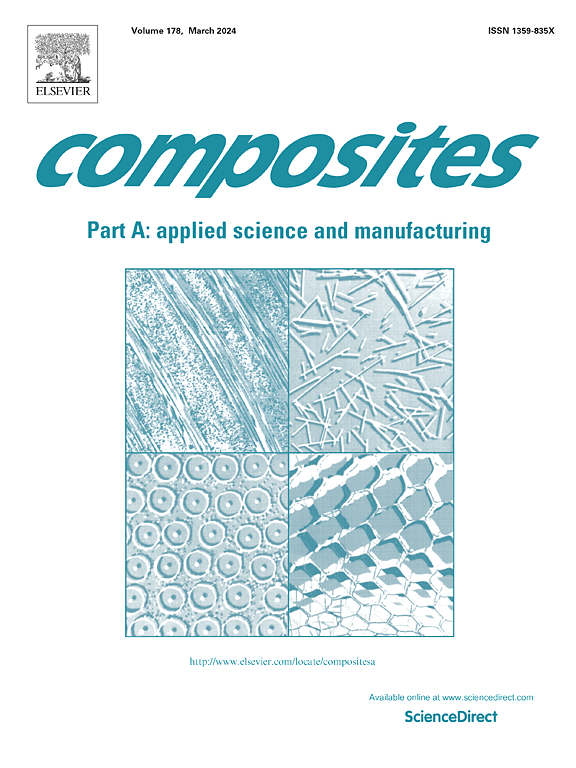电喷掩模印刷(CFx)n/CaF2-ZrO2交织涂层的微观结构和高温摩擦学性能
IF 8.1
2区 材料科学
Q1 ENGINEERING, MANUFACTURING
Composites Part A: Applied Science and Manufacturing
Pub Date : 2025-04-22
DOI:10.1016/j.compositesa.2025.108978
引用次数: 0
摘要
采用电喷掩模印刷技术制备了(CFx)n/CaF2-ZrO2交织涂层。研究了CaF2含量(0、25、50 wt%)对304不锈钢球高温(25、200、400℃)显微组织、粘接强度和磨损性能的影响。结果表明,涂层的交错结构有助于防止润滑油颗粒的损失,并减少了润滑油颗粒之间的实际接触面积。CaF2的加入降低了(CFx)n涂层的表面粗糙度和孔隙率,抑制了涂层的热失重和疲劳剥落。在25°C时,(CFx)n-ZrO2交织涂层的摩擦系数最低,为0.13,尽管脆性CaF2颗粒阻碍了润滑。在200℃时,CaF2的存在降低了摩擦副的磨损率。在400°C时,含有25 wt% CaF2的交错涂层的摩擦系数最低,为0.29,并且涂层和对应涂层的磨损率都很低。这种改善主要归因于高温下CaF2的脆性到延性转变和新润滑剂的形成。粘着磨损、氧化磨损和脱层是主要的磨损机制。本文章由计算机程序翻译,如有差异,请以英文原文为准。
Microstructure and high-temperature tribological properties of electro-jet mask printing (CFx)n/CaF2-ZrO2 interlaced coatings
The (CFx)n/CaF2-ZrO2 interlaced coating was prepared using electro-jet mask printing technology. The effects of CaF2 content (0, 25, 50 wt%) on its microstructure, adhesion strength, and wear properties against 304 stainless steel balls at high temperatures (25, 200, 400 °C) were investigated. The results indicated that the interlaced structure of the coating helped prevent the loss of lubricant particles and reduced the actual contact area between the counterparts. The addition of CaF2 reduced the surface roughness and porosity of the (CFx)n coating and suppressed thermal weight loss and fatigue peeling of the coating. At 25 °C, the (CFx)n-ZrO2 interlaced coating showed the lowest friction coefficient of ∼ 0.13, although the brittle CaF2 particles hindered lubrication. At 200 °C, the presence of CaF2 reduced the wear rate of the friction pair. At 400 °C, the interlaced coating with 25 wt% CaF2 showed the lowest friction coefficient of ∼ 0.29, and both the coating and counterpart had low wear rates. This improvement was primarily attributed to the brittle-to-ductile transition of CaF2 at high temperatures and the formation of new lubricants. Adhesive wear, oxidative wear, and delamination were the predominant wear mechanisms.
求助全文
通过发布文献求助,成功后即可免费获取论文全文。
去求助
来源期刊

Composites Part A: Applied Science and Manufacturing
工程技术-材料科学:复合
CiteScore
15.20
自引率
5.70%
发文量
492
审稿时长
30 days
期刊介绍:
Composites Part A: Applied Science and Manufacturing is a comprehensive journal that publishes original research papers, review articles, case studies, short communications, and letters covering various aspects of composite materials science and technology. This includes fibrous and particulate reinforcements in polymeric, metallic, and ceramic matrices, as well as 'natural' composites like wood and biological materials. The journal addresses topics such as properties, design, and manufacture of reinforcing fibers and particles, novel architectures and concepts, multifunctional composites, advancements in fabrication and processing, manufacturing science, process modeling, experimental mechanics, microstructural characterization, interfaces, prediction and measurement of mechanical, physical, and chemical behavior, and performance in service. Additionally, articles on economic and commercial aspects, design, and case studies are welcomed. All submissions undergo rigorous peer review to ensure they contribute significantly and innovatively, maintaining high standards for content and presentation. The editorial team aims to expedite the review process for prompt publication.
 求助内容:
求助内容: 应助结果提醒方式:
应助结果提醒方式:


